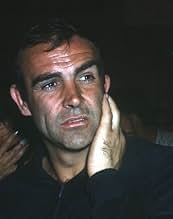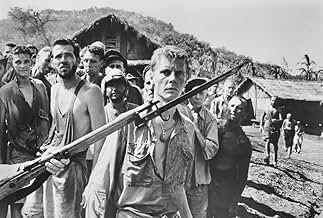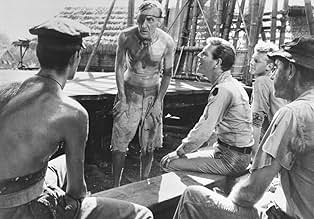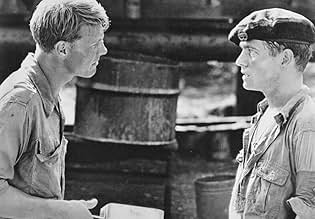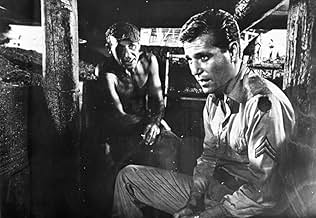IMDb रेटिंग
7.5/10
5.3 हज़ार
आपकी रेटिंग
अपनी भाषा में प्लॉट जोड़ेंFast-talking wheeler-dealer Corporal King is stuck in a Malaysian P.O.W. camp during World War II and uses bribery and larceny to take de-facto control of the camp.Fast-talking wheeler-dealer Corporal King is stuck in a Malaysian P.O.W. camp during World War II and uses bribery and larceny to take de-facto control of the camp.Fast-talking wheeler-dealer Corporal King is stuck in a Malaysian P.O.W. camp during World War II and uses bribery and larceny to take de-facto control of the camp.
- 2 ऑस्कर के लिए नामांकित
- 3 कुल नामांकन
Joe Turkel
- Dino
- (as Joseph Turkel)
Michael Stroka
- Miller
- (as Mike Stroka)
फ़ीचर्ड समीक्षाएं
"King Rat" is certainly NOT a fun nor enjoyable movie to watch. Now I am not saying it's bad nor should you avoid it...just understand that the film depicts a Japanese POW camp...and there's no way you could make that fun to watch.
The setting is a POW camp near Singapore. There's absolutely no place for the mostly British as well as a few American prisoners to run to and the Japanese keep rather lax security because of this. The prisoners also are dying rapidly due to starvation, no medications and the hellish conditions. However, in the midst of this, Corporal King (George Segal) manages to thrive. This is because he is a schemer and a survivor...operating a black market operation to get food and whatever he really needs. One of the other prisoners, Lt. Grey (Tom Courtenay), is just the opposite. Grey LOVES rules, power and playing a little god in the camp...and he wants to keep order, discipline and King under his control. To Grey, getting King to follow the rules and give up his black market activities seems to be his greatest aim. As for King, he pretty much ignores Grey and does what he does best...survives. And, if that means selling rat meat or eating dog, well, he'll do it in order to live.
As the description would indicate, the film is often rather grim. It's also an interesting character study of several of the inmates...not just Grey and King. Well acted, well made and well worth seeing...provided you can stand watching it. Now this is NOT one of the very worst war films...it's not nearly as bad as "Saving Private Ryan", "Burmese Harp" nor "Fires on the Plain"...but it still is tough. One of Segal's best.
The setting is a POW camp near Singapore. There's absolutely no place for the mostly British as well as a few American prisoners to run to and the Japanese keep rather lax security because of this. The prisoners also are dying rapidly due to starvation, no medications and the hellish conditions. However, in the midst of this, Corporal King (George Segal) manages to thrive. This is because he is a schemer and a survivor...operating a black market operation to get food and whatever he really needs. One of the other prisoners, Lt. Grey (Tom Courtenay), is just the opposite. Grey LOVES rules, power and playing a little god in the camp...and he wants to keep order, discipline and King under his control. To Grey, getting King to follow the rules and give up his black market activities seems to be his greatest aim. As for King, he pretty much ignores Grey and does what he does best...survives. And, if that means selling rat meat or eating dog, well, he'll do it in order to live.
As the description would indicate, the film is often rather grim. It's also an interesting character study of several of the inmates...not just Grey and King. Well acted, well made and well worth seeing...provided you can stand watching it. Now this is NOT one of the very worst war films...it's not nearly as bad as "Saving Private Ryan", "Burmese Harp" nor "Fires on the Plain"...but it still is tough. One of Segal's best.
I don't know exactly what I expected from "King Rat," but what I got definitely wasn't it, and I liked what I got much more than whatever it was I thought I was going to get.
I guess I thought "King Rat" was going to be something along the lines of "Stalag 17," a serious story in a serious setting, but with a buddy movie vibe and a lot of comedy thrown in. That is most certainly NOT what this movie is. "King Rat" is instead a bleak, haunting, and rather strange film about the simple act of survival in a Japanese prisoner camp during the last days of WWII. It's episodic in nature, detailing one grueling incident after another. It explores the degree to which imprisoned military men will impose a hierarchy one way or another, one that either does or doesn't always match the hierarchy of their military lives when free men. For example, at the top of the pecking order in this prison camp is George Segal, the eponymous king rat, who will stop at nothing to ensure his own comfort and who's an object of awe and even fear to those around him, even officers who outrank him. But then the war ends, the prisoners are set free, and everything goes back to the way it was. Where does that leave things like friendship, community, and just simple camaraderie, and where does that leave the conscience of men like King Rat, who exploited his brothers for all they were worth when times were tough.
The movie is tremendous, the performances are all uniformly fine, and director Bryan Forbes gives everything a naturalistic tone that makes the film feel like a product from a later date.
"King Rat" received Oscar nominations for its truly impressive art direction and cinematography, both in the black and white categories back in the days when distinctions were made between B&W and color films.
Grade: A
I guess I thought "King Rat" was going to be something along the lines of "Stalag 17," a serious story in a serious setting, but with a buddy movie vibe and a lot of comedy thrown in. That is most certainly NOT what this movie is. "King Rat" is instead a bleak, haunting, and rather strange film about the simple act of survival in a Japanese prisoner camp during the last days of WWII. It's episodic in nature, detailing one grueling incident after another. It explores the degree to which imprisoned military men will impose a hierarchy one way or another, one that either does or doesn't always match the hierarchy of their military lives when free men. For example, at the top of the pecking order in this prison camp is George Segal, the eponymous king rat, who will stop at nothing to ensure his own comfort and who's an object of awe and even fear to those around him, even officers who outrank him. But then the war ends, the prisoners are set free, and everything goes back to the way it was. Where does that leave things like friendship, community, and just simple camaraderie, and where does that leave the conscience of men like King Rat, who exploited his brothers for all they were worth when times were tough.
The movie is tremendous, the performances are all uniformly fine, and director Bryan Forbes gives everything a naturalistic tone that makes the film feel like a product from a later date.
"King Rat" received Oscar nominations for its truly impressive art direction and cinematography, both in the black and white categories back in the days when distinctions were made between B&W and color films.
Grade: A
I saw "King Rat" on television shortly before going to Vietnam. A few months later I was reading the James Clavell novel while serving on DaNang Air Base with air force communications intelligence. It struck me that this book and this movie, which was "researched" by James Clavell when he was a POW in a camp near Singapore during World War II, have the real feel of what it is to be surrounded by enemy forces one almost never sees while being kept isolated on a hot, humid, dusty encampment It's an environment that brings out the best and the worst in mankind. The novel, the movie, and my own war zone experience also point out that adapting to a war zone and mastering the skills that enable one to survive and even prosper there do not necessarily mean that the individual will subsequently be adaptable to "civilization" when he returns to it. The novel, the movie, and my own experiences also raise the questions that are raised in "The Man in the Gray Flannel Suit" (and even in "Rambo" for that matter): Which is more of a challenge and which is the "real" life: adapting to the war zone as a youth or the expectations by "civilization" that you readjust to life back in "the world" as if nothing had happened?
Many unforgettable films are to be found in the annals of World War II. Avid movie goers know which ones they are. Among my favorites are 'The Great Escape, The Blue Max, Cross of Iron, and of course, Sink The Bismark," But occasionally, a film is made which deviates from the superficial and ventures into the realm of the incredible. That is the essence of "King Rat." Here viewers are exposed to the harsh realities of what it takes to survive in a hell hole, like a Japanese Prisoner of War Camp. Our hero, one, Cpl. King (George Segal) dwells amid hundreds of starving British and a few American P.O.W.s. However, unlike the rest, who are seen as listless, emaciated and dying , King is for the most part, healthy and appears none the worse for wear. One individual who daily wants to know why King, walks about nearly impervious to the obvious conditions is Lt. Robin Grey (Tom Courtenay, convincing in this role). It is his job as Camp Provost Marshal, to maintain order in a camp where smuggling, trading with the enemy and outright theft is common place. Knowing King is secretly dealing with the enemy, Robin daily waits for him to make a mistake. This will be difficult as King relies on the fact, everyone, regardless of rank seeks to stay alive by whatever means. Aiding King is Peter Marlowe (James Fox) who despite his higher rank readily joins King's other 'employees' such as Tex, (Todd Armstrong), Top Sgt. Max (Patrick O'Neal, Lt. G.D. Larkin, (Denholm Elliott), and Col. George Smedley-Taylor (John Mills). But it is the camp Doctor (James Donald) who asks the pertinent question of King. "What is your secret Cpl? Medically, it should be worth a fortune." Throughout this stark and tragic Black and White film, one is equally curious, until we discover King's dark secret. Once we know it, the anger is dissipated by the fact, the war will eventually be over. Then Cpl. King will be called upon to reveal it. A superior movie with top notch acting by every actor. ****
I had never heard of this movie. It came on late one night on cable and I watched it. I was very impressed. The performances in the movie are Oscar caliber. George Segal gave probably the best performance of his career. He plays an American stuck in a Japanese POW camp who manages to always make some dough on the side. He is manipulative and arrogant but his performance is credible and appealing. Also, the way the camp itself is projected as a miserable, fly-infested, hot and godawful hellhole is hard to forget.
James Fox also gives an outstanding performance as Segal's British counterpart who come under Segal's spell and begins to do alot of his dirty work for him. This is a movie you will not soon forget. Now, keep in mind that since this movie was made in 1965, it is tame in terms of its depiction of violence but that does not take away from its overall message. Great movie!
James Fox also gives an outstanding performance as Segal's British counterpart who come under Segal's spell and begins to do alot of his dirty work for him. This is a movie you will not soon forget. Now, keep in mind that since this movie was made in 1965, it is tame in terms of its depiction of violence but that does not take away from its overall message. Great movie!
क्या आपको पता है
- ट्रिवियाDue to the cast, director and setting, this is often assumed to be a British movie, but it was entirely filmed in California.
- गूफ़The shoulder patch that Cpl. King (George Segal) is wearing is that of the 34th Infantry Division (Red Bull). The 34th ID served in the European Theater of Operations, not in the Pacific. The 34th ID patch is a black Mexican water jug called an "olla" with a red bull's skull superimposed. Almost all the POWs at Changi were British or Commonwealth soldiers captured at the surrender of Singapore on Feb. 15, 1942, but there also were POWs from the Netherlands East Indies, which surrendered in March. The only sizable U.S. unit at Changi was Co. E, 2nd Btn, 131st Field Artillery Regt., part of the Army's 36th ID (the "Texas Division"). The Second Battalion, which became known as the Texas National Guard's "Lost Battalion," was detached from the 36th ID in the States and shipped to the Pacific in November 1941, but when the Japanese attacked the Philippines in December, the battalion's convoy was diverted from Manila to Brisbane, Australia. In January the battalion was sent to Java, in the Netherlands East Indies. The battalion was the only U.S. ground unit in Java when the NEI surrendered to the Japanese on March 9, 1942. Most men in the battalion were transferred to Singapore later that year and, along with thousands of British and Commonwealth soldiers, were used by the Japanese as slave labor to build the infamous "Death Railway" connecting Bangkok to Rangoon. Company E of the 2nd Battalion, separated from the rest of the unit on Java, was at Changi briefly in October-November 1942 before being sent to Japan as slave laborers. It would be plausible that Cpl. King was a member of 2nd Battalion, 131st Field Artillery, and that the movie's costumers got the wrong division patch for his uniform.
- क्रेज़ी क्रेडिट[Prologue] This is not a story of escape. It is a story of survival.
It is set in Changi Jail Singapore, in 1945
The Japanese did not have to guard Changi as a normal prison of war camp. The inmates of Changi had no friendly Swiss border or any other neutral country within reach. They were held captive not so much by high walls, or barbed wire, or machine-gun posts, but by the land and sea around them - and the jungle was not neutral, nor was the ocean.
They did not live in Changi. They existed. This is the story of that existence.
- कनेक्शनFeatured in A Walk on the Moon (1999)
- साउंडट्रैकAdeste Fideles
(uncredited)
Written by Frederick Oakeley (1841)
Variation sung in distant background by POWs
टॉप पसंद
रेटिंग देने के लिए साइन-इन करें और वैयक्तिकृत सुझावों के लिए वॉचलिस्ट करें
- How long is King Rat?Alexa द्वारा संचालित
विवरण
- चलने की अवधि2 घंटे 14 मिनट
- रंग
- पक्ष अनुपात
- 1.85 : 1
इस पेज में योगदान दें
किसी बदलाव का सुझाव दें या अनुपलब्ध कॉन्टेंट जोड़ें



